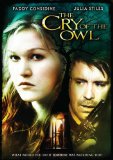You may not know the name Patricia Highsmith, but you do know her work. She penned the novel that brought us Alfred Hitchcock’s excellent thriller Strangers On A Train. You might also know her character Thomas Ripley, who was the subject of several of Highsmith’s novels including the famous The Talented Mr. Ripley. Most of these works appeared in the 1950’s and 1960’s. Still, her work has been tapped for motion pictures right up through the most recent film The Cry Of The Owl.
Now see if you can follow any of this. The film is a cooperation between an American company and Britain’s BBC as well as a French company. The lead is Paddy Considine, a Brit. Of course, he’s playing an American in the film. The film is set in some undisclosed, but presumably New York, American big city and a surrounding small town. But, the film was lensed in Ontario, Canada. Got that? It’s very much an independent-feeling film and is a direct-to-video release.
Robert Forrester (Considine) is a pretty messed up guy. He has a history of depression, and life isn’t handing him a bowl full of cherries at the moment we meet him. His awkwardness at work is getting him in trouble. His wife is divorcing him. Although just one minute with his wife and you might be tempted to chalk that one in the lady luck department. On his way home each night he walks by a neighbor’s house to watch a young lady, Jenny (Stiles) at her kitchen sink. It’s not really a sexual stalking, as he only watches her in the kitchen. Jenny has a boyfriend, Greg (Gilbert) who almost catches Robert in the yard on one occasion. But things change one night when Jenny catches him looking at her. Instead of being creeped out, she actually invites her stalker into the house. After an odd conversation about fate, she sends him on his way with a cookie.
The next day she shows up at Robert’s work, and eventually everywhere. It appears the tables have turned, and now Jenny finds herself stalking Robert. This creeps Robert out a bit. Imagine that. The creepy guy is getting creeped out. When Jenny breaks up with Greg to be with Robert, the new ex-boyfriend isn’t going to take things very calmly. He goes after Greg, and the two have a vicious fight. Greg disappears after the fight; the police suspect he’s dead, and Robert’s walking around as the most likely suspect. Jenny continues to cling to him, but everyone else is keeping their distance. On top of all of that, someone is now trying to kill him. Did Robert kill his rival? Did Jenny kill him or maybe manipulate Robert to do it for her? The answer is pretty messed up.
I’ve never read the Patricia Highsmith source material, but I’ll bet that it’s rich in atmosphere, if a bit dated by this point. I have read Strangers On A Train and remember that she was a master, not of suspense, but of atmosphere. Unfortunately, that’s the only thing this movie is missing. The two leads are quite good here; in fact I’d call both performances excellent. The supporting cast includes some powerful performances as well. Caroline Dhavemas plays Robert’s rather cruel wife so perfectly that it doesn’t take much to hate her from the start. Of course, the story has some incredible beats and a rather clever way of playing it all out. No question the plot and pace are balanced just right to keep you engaged the entire time. It’s a good movie and one I recommend you rent.
Video
The Cry Of The Owl is presented in its original aspect ratio of 2.35:1. The transfer has a bit of a glossy edge and displays pretty solid color at times. A lot of the film takes place at night, so it’s fortunate that the film displays good black levels. There are times that the film appears to be washed of color. I suspect it was an attempt at mood or color. It wasn’t nearly enough to establish that. If the transfer suffers at all, it suffers by a tendency to go overboard either dark or light. The “normal” scenes while Robert is at the office look the best. Unfortunately, they are the least important.
Audio
The Dolby Digital 5.1 is not going to impress those audiophiles in the audience. The dialog is solid. The score works for what it tries to do. There isn’t anything aggressive or impressive about the surround usage. It’s a very moody and, at times, mundane audio presentation that can tend to slow things down a bit.
Special Features
Nothing
Final Thoughts:
This could be a great movie, worthy of Hitchcock’s talents. But this isn’t Hitchcock. It’s James Thraves, and Thraves hasn’t been doing this long enough to know just how good he could be. All I know is he let a perfect storm of story and character, played by good actors, slip from his fingers. Maybe it’s the locations. Maybe it’s the direction itself. There just isn’t any luster or atmosphere to the production. Thraves may have a phenomenal career. I don’t know. But this one is going to haunt his nightmares no matter how his career goes. This is always going to be the one that got away, the one that was just this close to being great. It’s a hair’s width, to be sure. But when you’re talking about great films and simply good films, that hair might as well be a million miles wide. Thraves, you have all the crucial elements at your fingertips, but “you’re not playing the game right”.





